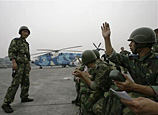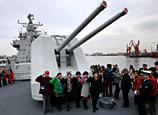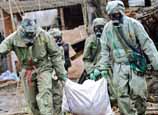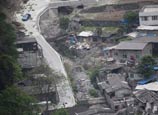
BEIJING, April 25 (Xinhua) -- China's dealing with the aftermath of a deadly earthquake in its southwestern Sichuan province has continued to draw a strong response from the international community.
European Union (EU) foreign policy chief Catherine Ashton said Tuesday in a statement, "On the eve of my visit to Beijing, the news of the earthquake in Sichuan Province has profoundly moved me. I send my condolences to the families of those affected."
"The resilience of the Chinese people in the face of disaster and the work done by volunteers on the scene are impressive," she said.
Media in other countries have given extensive coverage to the relief efforts by Chinese authorities and individuals, and some have spoken highly of authorities' quick response.
USA TODAY reported Tuesday that China sent some 18,000 soldiers and armed police to the disaster zone, and helicopters and planes were also dispatched for rescue missions.
"Chinese Premier Li Keqiang visited injured survivors Sunday before returning to Beijing."
"In the immediate aftermath of Saturday's quake, Chinese Internet users focused on trying to help. Bloggers in the quake zone turned Saturday to Sina Weibo, a Twitter-like service, to call for assistance. Organizations and individuals quickly volunteered help. Other volunteer efforts also spread via Weibo," it said.
In its report Tuesday, Houston Chronicle detailed China's full range of disaster response measures, including portable ATMS, phone-charging stations, trucks with X-ray equipment, and a tent for insurance claims.
"The efforts under way in mountainous Sichuan province showed the Chinese government has continued to hone its disaster reaction -- long considered a crucial leadership test in China," it said.
Frankfurt General Newspaper, a national German newspaper, said the fact no students died from the collapse of schools showed buildings there had become more quake-resistent and had withstood a major test.
Japan's Asahi Shimbun published a similar report Tuesday, saying disaster relief efforts were well under way.
The Singarpore-based daily newspaper Lianhe Zaobao reported Tuesday that countries emerging from disasters would become more resilient and calmer.
Since a devastating earthquake in 2008 in China's Sichuan province and another one in 2010 in the western region of Yushu, China's relief efforts had become more professional, cool-headed and self-restrained and Chinese people were confident about the country's rescue system, the newspaper said.
The Associated Press reported Monday that, after dynamiting through landslide-blocked roads, Chinese relief crews hurried food, water and other supplies into the rural hills of China's Sichuan province.
"Rescuers reached the most cut-off communities in Baoxing and Lushan counties, though heavy machinery and trucks bearing supplies moved slowly along roads partly blocked by landslide debris. Repairmen hoisted ladders up against electrical poles to fix power lines," the report said.
Chinese Premier Li Keqiang arrived Saturday afternoon by helicopter in Ya'an to direct rescue efforts. He ordered the saving of lives as the "priority".
In its report Monday, Agence France-Presse (AFP) said thousands of rescue workers combed through flattened villages in southwest China on Sunday in a race to find survivors.
President Xi Jinping ordered all-out efforts to minimize casualties, said the report. And "China's new Premier Li Keqiang rushed to the disaster zone to oversee rescue efforts."
The response on China's "weibo" sites to Saturday's quake had overwhelmingly been one of support, with thousands pledging to donate money and others mourning the victims, the AFP reported.
A 7.0-magnitude earthquake jolted Lushan County of China's Sichuan province Saturday, leaving 196 people dead and 11,470 others injured, according to latest figures. Twenty-one people remain missing.
















 Giant pandas safe in quake-hit zone
Giant pandas safe in quake-hit zone


![]()
